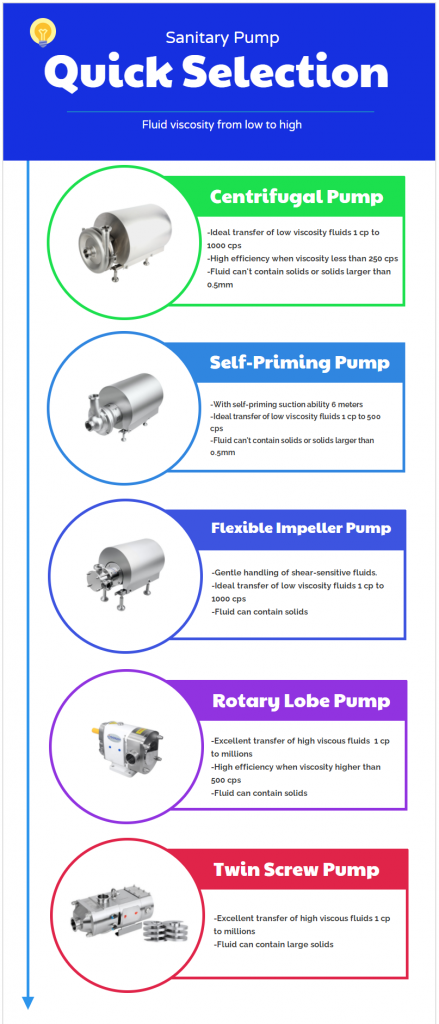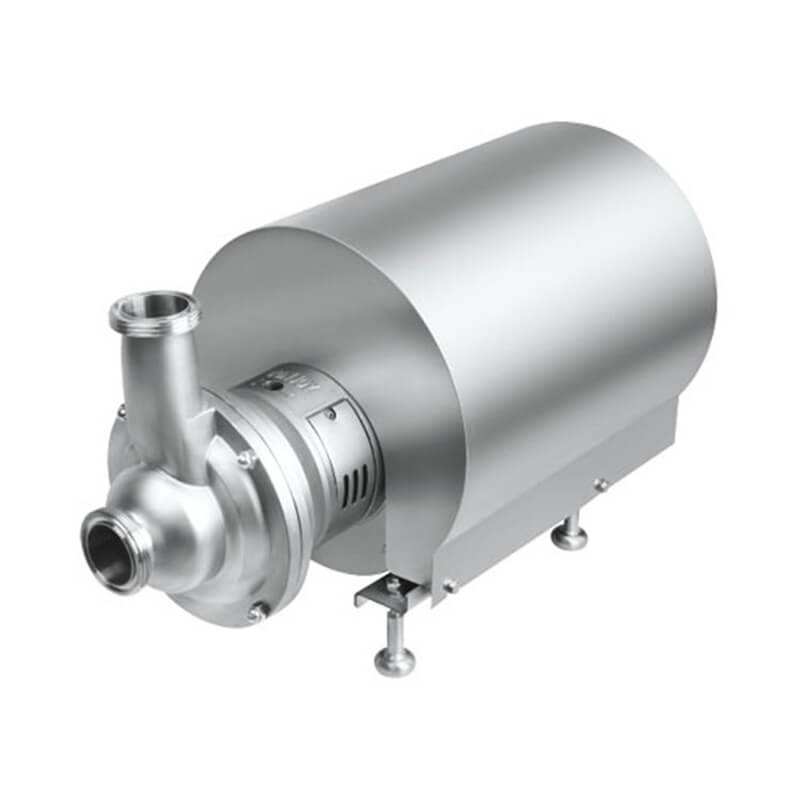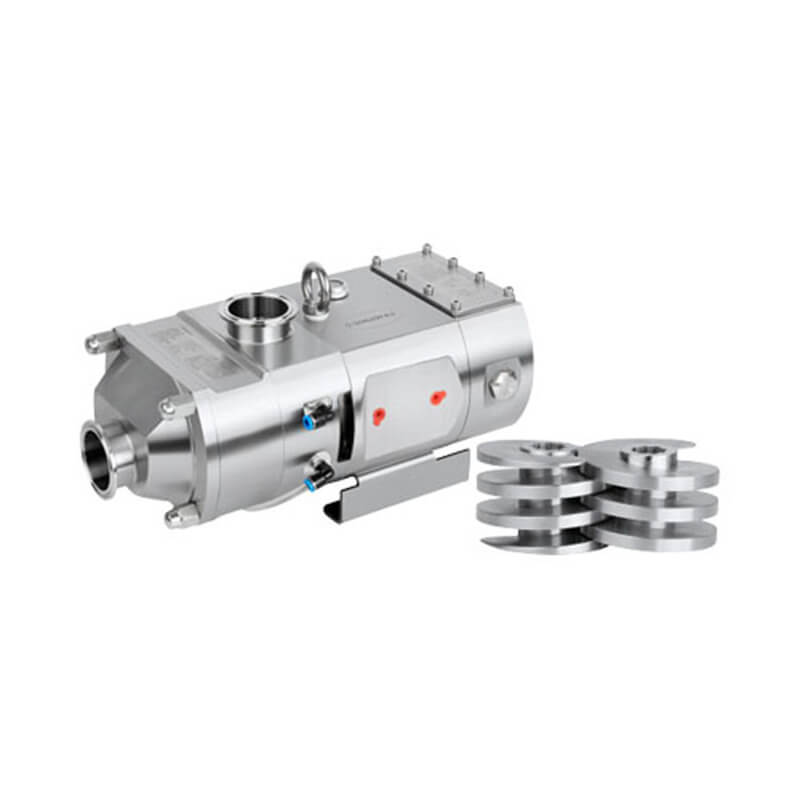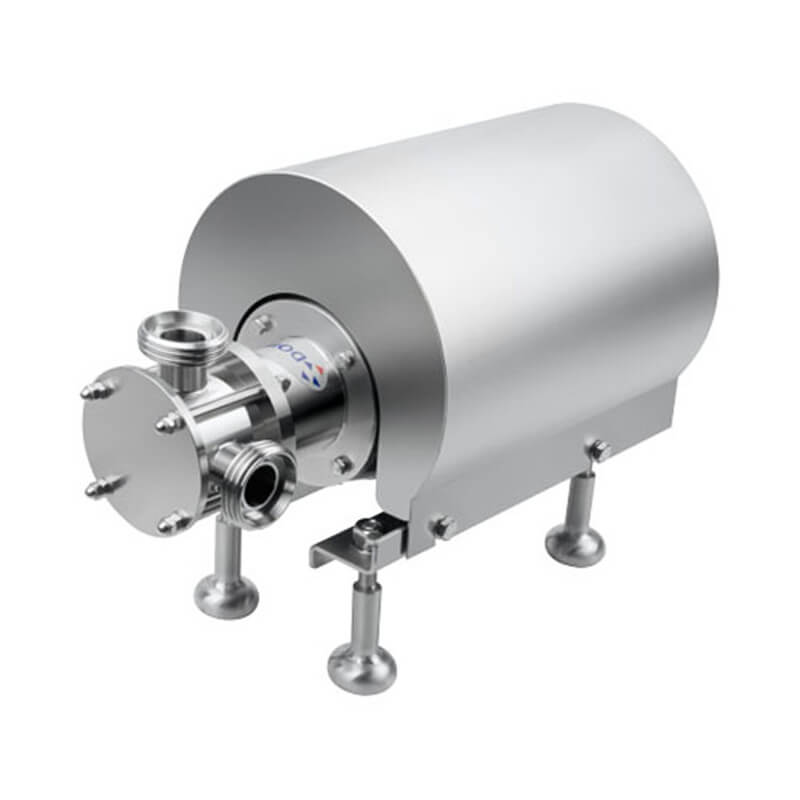Before that you should figure out your pump application, sanitary pump regularly require to use high clean stainless steel material, sanitary applications e.g. food processing, dairy, beverage, daily chemical, pharmaceutical industry… Industrial application pump material normally is carbon steel, cast iron, copper… Industrial applications require a larger flow than the sanitary pump, up to hundreds of cubic meters per hour, industrial application e.g. oil, gas, agricultural, sewage treatment…
Fluid Data
The essential information about the liquid you need to transfer.
Viscosity
Temperature
Shear sensitivity
Solids content (size & concentration)
Fluid type (hazardous, toxic, abrasive, etc.)
Among the many factors that influence pump selection and performance, flow requirements, pressure requirements, and fluid characteristics are at the top of the list.
Flow Requirements
Knowing your flow rate requirement is a must for pump sizing. It is one of the two primary factors for evaluating a performance curve. If your flow rate requirement isn’t already a known value dictated by your process, it can be easily determined. Since flow is measured as volume over time, you need to know how much fluid you need to transfer (volume) and how long you have to transfer it (time).
EXAMPLE: YOU NEED TO TRANSFER 1000 GALLONSOF FLUID IN 20 MINUTES; 1000 ÷ 20 = 50 GPM.
Viscosity
It’s important to factor in pump selection. It’s the resistance of a fluid to flow. When a fluid (gas or liquid) flows, it gets resistance, which is the internal friction of the fluid. To make the fluid flow, it is necessary to add all the linear forces in the direction of fluid flow to counteract the effect of resistance.
Before choosing a pump or determining the size of the pump, be sure to determine the viscosity of your fluid. You need a viscosimeter to measure the viscosity of the fluid. If you don’ have it, we can refer to this article with video of Viscosity Comparison Guide
Then we can simply choose pump by fluid viscosity.

Please see below for the characteristics of each pump
Hygienic Centrifugal Pump

The centrifugal pump works by using the impeller to rotate and make the water produce centrifugal force. Before starting the pump, the pump casing and inlet pipe must be filled with water, then start the motor, so that the pump shaft drives the impeller and the water to do high-speed rotational centrifugal movement, was thrown to the outer edge of the impeller, through the worm-shaped pump casing of the flow channel into the pump pressure pipe.
DONJOY centrifugal pump ideal to transfer media low viscosity fluids, Since less viscous liquids are much easier to accelerate with kinetic energy, centrifugal pumps can transfer them much more efficiently than other designs. Not all products are a good fit for the centrifugal pump design. The high-speed impeller creates a very dynamic environment inside the pump casing, which may be harmful to some shear-sensitive fluids.
Centrifugal Pump Advantage
- Ideal to transfer of low viscosity fluids.
- With high flow rate can easily meet your flow request.
- Install a valve at outlet can easy to control flow rate.
- Steady, pulsation-free output.
- Low purchase cost and maintenance cost comparing with other pumps.
- Long life spans and have low routine maintenance requirement.
Centrifugal Pump Disadvantage
- Not recommended for viscous liquids.
- Not recommended for fluids with large suspended solids.
- Not recommended for shear-sensitive fluids.
Hygienic Self-Priming Pump

It is similar to the centrifugal pump, but the difference is it has self-priming suction ability max 6meters
Self-Priming Pump Advantage
- Ideal to transfer of low viscosity fluids.
- It has self-priming suction ability max 6 meters
- Highly effective as a CIP return pump.
Self-Priming Pump Disadvantage
- Not recommended for viscous liquids.
- Not recommended for fluids with large suspended solids.
- Low flow and head compared to standard centrifugal pumps.
Hygienic Flexible Impeller Pump
As the name suggest, it with special design flexible impeller food grade EPDM or Viton material, self-priming up to 6 meters, soft and gentle pumping shear-sensitive fluids and fluids containing soft or fragile solids kept in suspension, suitable to transfer fluids viscosity less than 1000cps, e.g. milk, cream, yoghurt.
Flexible Impeller Pump Advantage
- Suit for pumping shear sensitive fluids and containing fragile solids
- Self-priming up to 6 meters
Flexible Impeller Pump Disadvantage
- Not recommended for viscous liquids.
- Low flow and head compared to standard centrifugal pumps.
Hygienic Rotary Lobe Pump

Donjoy Rotary lobe pump is a kind of positive displacement pump, with sanitary design 3A certified. The pump has two shafts and two cams, some times call it a cam pump. The rotary lobe pump is generally unaffected by system pressures, so it generates a constant flow regardless of changes in the process head pressure. And since it discharges a specific amount of fluid per revolution, the output is easily controlled by varying the pump speed, typically with a variable frequency drive (VFD).
It is suitable to transfer high and low viscous fluids, recommend to transfer media viscosity more than 500cps, can transfer fluid contains small particles, large particle recommends to use twin-screw pump. Perfectly use in food processing, dairy, beverage, cosmetic, Pharmaceuticals…
Rotary Lobe Pump Advantage
- Ideal to transfer high viscosity fluids.
- Offers accurate and consistent output.
- Reversible direction of flow.
- Output can be controlled by varying drive speed.
Rotary Lobe Pump Disadvantage
- Low viscosity fluids can“slip”at high output pressures, reducing efficiency, not recommend to transfer low viscosity fluids
- Typically driven with motor/gear reducer unit creating large footprint.
- Moderate flow and pressure pulsation.
Hygienic Twin-Screw Pump

The twin-screw pump is a positive-displacement (PD) pump that use two screws to move high and low visousity fluid and contain large particles, soft handling keep particle intact, capable of handling shear-sensitive products, recommend to transfer very high viscosity fluids, suitable to use in CIP and SIP system, reversible direction of flow.
Twin-screw pump pumped fluid flows through screws in an axial direction. Twin-screw pumps can operate over a wide speed range to function in hygienic applications for pumping products at low speed and CIP fluid at high speed.
Twin-Screw Pump Advantage
- Wide range of flows and pressures.
- Gentle handling of most solids.
- Wide range of liquids and viscosity.
- High tolerance for entrained air.
Twin-Screw Pump Disadvantage
1.More complexity compared to other types of pumps, higher purchase cost.
2. To accommodate both process and CIP applications, twin screw pumps need to use larger motors than other types of pumps.
Pump Performance & Application Factors
Pump Performance Curves
The most important link between your specific application factors and proper pump selection is the manufacturer’s pump performance curves. Published by the pump manufacturer, they accurately predict how a particular pump will perform in varying conditions.The composition of the performance curve varies from manufacturer to manufacturer, but they generally include most of the performance data you need to begin sizing your pump.
4 things need to know before purchasing a sanitary pump
Purchasing a pump can be overwhelming, but once you’ve answered these four specifications, you will be ready to make a decision.
First, determine the flow rate.
This measures how much fluid is moving and how fast through your process system. Typically represented as gallons per minute (gpm), liters per minute (lpm) or cubic meters per hour (m3/h).
Second, determine pressure or head. A measure of force per unit of area, such as pounds per square inch (psi). In terms of pump performance, pressure is a way to define how much resistance the pump can overcome in order to transfer fluid.
Third, determine what the fluid is and its characteristics; what is the application?. Is it dense? What are the temperature requirements? What is the size of the contents?
Fourth, how will the pump be powered? Is it indoors or outdoors?
Starting with these four steps will assist your DONJOY pump expert in helping you select the best pump for your application. DONJOY is known in the sanitary industry as a leader in China.
To speak with a Pump expert email donjoy14@cndonjoy.com


1 thought on “How to Choose a Right Sanitary Pump”
Recently, one of my cousins decided he wanted to start investing in an industrial plant, but he’d like to make some renovations first. It’s good to know why you must consider your pump’s location before buying one, so I think my cousin could benefit from reading your insight. Thanks for the insight on sanitary pumps and what elements to think about before purchasing one.